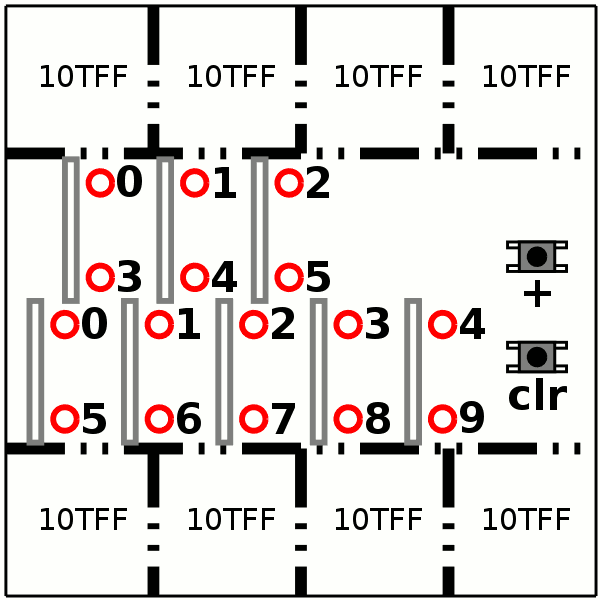I was stuck yesterday but the seeds have been received today ! I can work on the next PCB :-)
I have found a pretty versatile solution that does all the counters for hours, minutes or seconds, with a single 100mm×100mm PCB. This exploits the similarities so we only have to deal with a little quirk for the hours but the same PCB can be used in 2 configurations : count to 60 or count to 24.
In all the cases, there are 8 10TFF modules, that use one half of the PCB. The other half is a rectangle that holds the modules and wires them together. The whole set is very easy to manufacture in any PCB house.
The panelized boards are shown below:

On this board, the LED are red but the color can change. Actually I'd like to have red for the hours, green for the minutes and blue for the seconds (and something else for the tens of seconds ?)
The board uses the same 10-stages Johnson counter for the bottom decade, the upper counter can be wired in two different ways :
- for the seconds and minutes, a 6-stages Johnson counter (with all the 6 LEDs plugged)
- for the hours, a 3-bits shift register (3 LEDs are wired)
The difference is how you wire the 3×10TFF modules:
- The loopback is either twisted (Q and /Q are switched) to make a regular or twisted shift register (thus doubling the number of states)
- The reset status is all 0s for the Johnson counter, or 100 for the regular shift register.
The above changes are applied by soldering the proper jumpers, or diodes on one of the modules.
(Update: well, no need to hack the diode, just rewire Q and /Q, D and /D, a few jumpers !)
The hour configuration must also reset the whole board when it reaches the value 24, so it must actually detect the value 23, latch it and pull the reset down when the next clock pulse is received. This is similar to the circuit explained in Divide by 15 but with different conditions, and a REAL CMOS AND3 gate to prevent power losses through the pull-down resistor.
Now, considering that the LEDs will draw "some power" anyway, a 1MΩ resistor will not significantly affect the general consumption. The hours don't change fast so a high RC time constant is possible.
 Yann Guidon / YGDES
Yann Guidon / YGDES
Discussions
Become a Hackaday.io Member
Create an account to leave a comment. Already have an account? Log In.